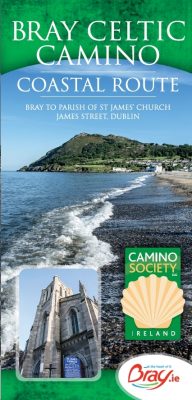
By Cian Molloy - 23 February, 2020
More than a thousand people have completed the Bray Celtic Camino since the 30km pilgrimage route was established a year and a half ago, according to the Camino Society of Ireland.
The mainly coastal route from Bray to St James’s Church in Dublin city centre, via Shankill, Dún Laoghaire and Blackrock, is set out in a leaflet published by Bray Tourism that is now on its second print run. The route description can also be downloaded from the website Bray.ie, where it is the most popular download on the site.
The Bray Celtic Camino came into being two years ago because the cathedral authorities in Santiago in Northern Spain agreed to a rule change for pilgrims completing the route. Previously, pilgrims had to walk the last 100km of their journey (or ride a horse or bike for the last 200km) in Spain to obtain the official certificate of completion, known as a ‘compostela’, which also earns a plenary indulgence.
This modern-day condition was at odds with the traditional route used by Irish, British and northern European pilgrims who would disembark at the port of A Coruña after sailing to northern Spain and travel along a route known as ‘El Camino Inglés’. Records show, for instance, that in 1473 a vessel carried 400 pilgrims from New Ross to A Coruña. The medieval departure point in Dublin gives its name to the James’s Gate Brewery where Guinness is manufactured today.
Two years ago, largely as a result of lobbying by A Coruña’s tourist industry, the cathedral authorities at Santiago in northern Spain relaxed the rules so that pilgrimage walks of up to 25km in length in pilgrims’ home countries may be included in the 100km needed to earn the compostela.

The Bray Celtic Camino route map
Any pilgrimage route may be chosen – but if you want to eventually earn the compostela – you must keep a written record of your journey: the Bray Celtic Camino route, for example, includes locations where you can have your ‘Pilgrim Passport’ stamped and signed to prove you passed along that way. Pilgrim passports, known as credencials, can be obtained from the Camino Society of Ireland, which is located in St James’s Church in Dublin.
“You can walk any pilgrimage route you like to complete the 25km in your home country,” said Joe Maguire, a member of the Camino Society of Ireland’s board. “But the society recommends eight Irish pilgrimage routes in particular: the Croagh Patrick Heritage Trail and Tochar Padraig in Mayo, the Kerry Camino, St Finbarr’s Pilgrim Path in Cork, St Declan’s Way in Waterford and Tipperary, the walk from Fore Abbey to Mullingar in Westmeath, St Kevin’s Way in Wicklow and the Bray Celtic Camino.
“The Bray Camino has the advantage of finishing at St James’s Church in Dublin, where the Camino Society office is based. It also passes St James’s Church, Crinken, near Shanganagh Park. It appears to be the most popular Camino route in Ireland – we are getting people travelling from England and the United States to complete it. Some people complete the route in a day, other people do it over two days, maybe over two weekends, but it is a very nice route.”
If you want to download a copy of the Bray Celtic Camino Coastal Route visit: www.bray.ie.
Last year, 6,826 Irish people completed the pilgrimage to Santiago de Compostela, a fall on the previous year when 7,548 people from Ireland made the journey. The Irish now account for the eighth largest ‘foreign nationality’ to make the journey, their position as the seventh largest group has been taken by pilgrims from Korea.